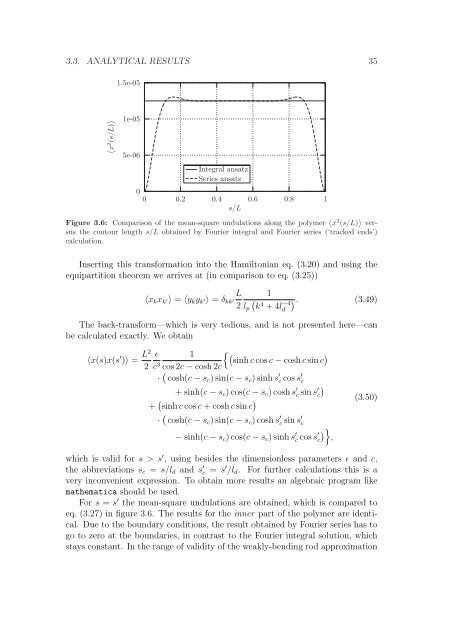Polymers in Confined Geometry.pdf
Polymers in Confined Geometry.pdf
Polymers in Confined Geometry.pdf
You also want an ePaper? Increase the reach of your titles
YUMPU automatically turns print PDFs into web optimized ePapers that Google loves.
3.3. ANALYTICAL RESULTS 35<br />
x 2 (s/L) <br />
1.5e-05<br />
1e-05<br />
5e-06<br />
0<br />
0<br />
0.2<br />
Integral ansatz<br />
Series ansatz<br />
0.4<br />
Figure 3.6: Comparison of the mean-square undulations along the polymer x 2 (s/L) versus<br />
the contour length s/L obta<strong>in</strong>ed by Fourier <strong>in</strong>tegral and Fourier series (‘tracked ends’)<br />
calculation.<br />
Insert<strong>in</strong>g this transformation <strong>in</strong>to the Hamiltonian eq. (3.20) and us<strong>in</strong>g the<br />
equipartition theorem we arrives at (<strong>in</strong> comparison to eq. (3.25))<br />
s/L<br />
L<br />
〈xkxk ′〉 = 〈ykyk ′〉 = δkk ′<br />
2<br />
lp<br />
0.6<br />
0.8<br />
1<br />
.<br />
k4 −4<br />
(3.49)<br />
+ 4ld The back-transform—which is very tedious, and is not presented here—can<br />
be calculated exactly. We obta<strong>in</strong><br />
〈x(s)x(s ′ )〉 = L2<br />
2<br />
ɛ<br />
c 3<br />
1<br />
s<strong>in</strong>h <br />
c cos c − cosh c s<strong>in</strong> c<br />
cos 2c − cosh 2c<br />
· cosh(c − sc) s<strong>in</strong>(c − sc) s<strong>in</strong>h s ′ c cos s ′ c<br />
+ s<strong>in</strong>h(c − sc) cos(c − sc) cosh s ′ c s<strong>in</strong> s ′ c<br />
+ s<strong>in</strong>h c cos c + cosh c s<strong>in</strong> c <br />
· cosh(c − sc) s<strong>in</strong>(c − sc) cosh s ′ c s<strong>in</strong> s ′ c<br />
− s<strong>in</strong>h(c − sc) cos(c − sc) s<strong>in</strong>h s ′ c cos s ′ c<br />
<br />
1<br />
<br />
,<br />
(3.50)<br />
which is valid for s > s ′ , us<strong>in</strong>g besides the dimensionless parameters ɛ and c,<br />
the abbreviations sc = s/ld and s ′ c = s ′ /ld. For further calculations this is a<br />
very <strong>in</strong>convenient expression. To obta<strong>in</strong> more results an algebraic program like<br />
mathematica should be used.<br />
For s = s ′ the mean-square undulations are obta<strong>in</strong>ed, which is compared to<br />
eq. (3.27) <strong>in</strong> figure 3.6. The results for the <strong>in</strong>ner part of the polymer are identical.<br />
Due to the boundary conditions, the result obta<strong>in</strong>ed by Fourier series has to<br />
go to zero at the boundaries, <strong>in</strong> contrast to the Fourier <strong>in</strong>tegral solution, which<br />
stays constant. In the range of validity of the weakly-bend<strong>in</strong>g rod approximation













